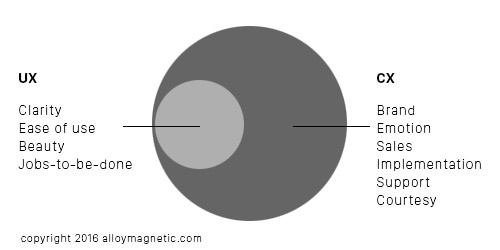Great brands know that experience matters. Anyone who has stayed at a decent hotel or eaten at a well-run restaurant knows how service is something worth paying for. Blue-chip brands, luxury auto dealers, resorts and hotels expecially have put time into intentionally designing your whole experience from your first steps through the door, to you pulling through the exit gate.
At Alloy, we have enjoyed watching customer experience come of age. For the first time in our careers, a solid vocabulary is developing for the work we have done for years — combining user experience, marketing, sales and support. Customer experience (CX) is an umbrella term that captures and coordinates all these things to work together across your services and products. For us at Alloy, it relies heavily on the same skill sets we have developed in our traditional disciplines. CX is the natural evolution of our core values of usability, high technology, design and communication.
One of the reasons that CX is coming into focus is that old methods of growth are less and less effective. There is more advertising than ever, and more of it is ignored. Buyers are looking for value, not necessarily the best price — that kind of shopping means they are relying more and more on reviews, blog posts and recommendations from friends. With all that research the experience around your product and service is a key component to your success and becomes vital to your marketing plan.
For years, many folks preferred shopping at Target over Walmart for the same kinds of items, simply because of the customer experience. Walmart, long focused strictly on prices, took these lessons to heart as Amazon ate away at its market share. In 2015 Walmart made a renewed investment in service, with its CEO announcing the company “would invest $2.7 billion over the course of two years to improve its training processes, and give a two-stage, broad-based pay increase to millions of workers.” That exhaustive new training program lasts six months and requires real growth from the employee. The results have been higher customer satisfaction:
For the past 84 weeks, customers have reported higher satisfaction on their stores' cleanliness, speed and customer service through an internal survey.
Your website is where prospects discover, research and engage with your business. The historic analog would be a customer’s first phone call to your business or their first time visiting your retail location — something highly dependent on the employee who assists the customer. Great brands understand those same impressions need to translate to the web experience.
Here are some key points to consider about digital CX:
- Support is the core of CX. Existing customers want the same treatment they got during the sales experience. A customer support process that makes their needs priority and is designed around proactive communication is the start to a CX program.
- Brand websites should go beyond messaging to inform prospects with the best information you can offer. Just as an expert employee will build rapport through her knowledge and help, your website should strive to be user-friendly and informative.
- CX requires personalization. Many companies don’t think about how personalization can shape a web experience, particularly in marketing. Today’s tools allow even small players to build a robust profile of their website visitor. This allows them to customize content based on their interests, their past interactions with the brand, and the opportunities ahead for them. Just like a great salesperson or account manager, your digital assets can "know" your customer.
- CX requires coordination across teams. Support needs to understand how sales and implementation operate and what has been communicated to the customer. Great customer experience requires that every department has a solid understanding of the brand and the rest of operations, regardless of their roles.
- User experience doesn’t equal customer experience.

- Feedback matters. Having an active program to collect customer feedback is key to doing a better job with CX.
The Internet and mobile technology have led to the fastest evolution of business communication and service that has ever been seen. As the sophistication of businesses and retail continue to grow, the importance of continuity and quality of service across transactions will be paramount to most marketing strategies. A company website and web products are the most cost-effective places to put customer experience practice into place and to measure the outcomes.